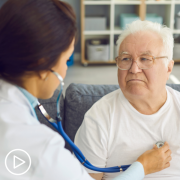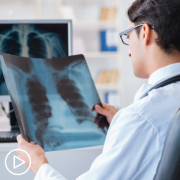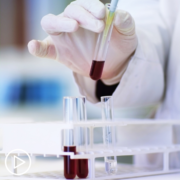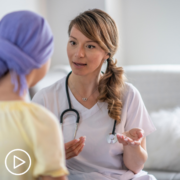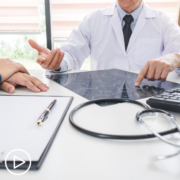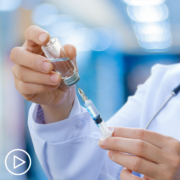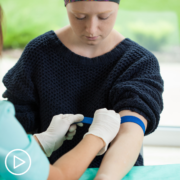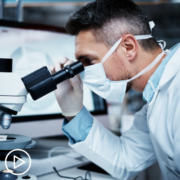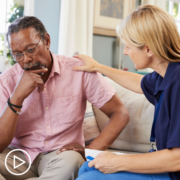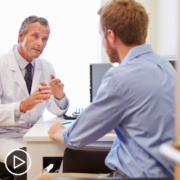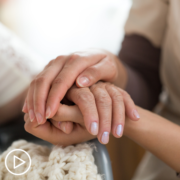What do you need to know before deciding which treatment is best for YOUR CLL? Dr. Lindsey Roeker discusses the role of key CLL tests, including biomarker testing, reviews emerging research, and provides tips for partnering with your care team to advocate for the best care.
Katherine:
Hello, and welcome. I’m Katherine Banwell, your host for today’s program. Today we’re going to discuss how to access the most personalized CLL treatment for your individual disease, and why it’s essential to insist on key testing. Before we meet our guest, let’s review a few important details. The reminder email you received about this program contains a link to program materials. If you haven’t already, click that link to access information, to follow along during the webinar.
At the end of this program, you’ll receive a link to a program survey. Please take a moment to provide feedback about your experience today, in order to help us plan future webinars. And finally, before we get into the discussion, please remember that this program is not a substitute for seeking medical advice. Please refer to your healthcare team about what might be best for you. Joining me today is Dr. Lindsay Roeker. Dr. Roker, thank you so much for joining us. Would you introduce yourself?
Dr. Roeker:
Absolutely. So, my name is Lindsey Roeker, and I am a member of the CLL program at Memorial Sloan-Kettering Cancer Center in New York City.
Katherine:
Excellent, thank you. Let’s start at the beginning. How is CLL diagnosed?
Dr. Roeker:
Absolutely. So, for most patients, CLL is diagnosed after a routine blood test shows a high white blood cell count. That’s kinda the most common way that we find people entering into our clinic. Other things that people can notice is they have lumps or bumps that they’ve felt in their neck or under their armpits. Those are some other symptoms that can lead to the diagnosis, but often once a patient finds that their white blood cell count is high, some additional testing is done, and the diagnosis of CLL is made.
Katherine:
What are some common symptoms of CLL? You mentioned the lumps and bumps.
Dr. Roeker:
Yeah. So, often in early stages, the lumps and bumps in the neck are the most common that people recognize, but fevers or chills, night sweats, where patients are waking up drenched, having to change their pajamas, or weight loss without trying, are some other symptoms that can raise some alarm bells and make people start looking for something.
And CLL can be a diagnosis that can be found through that, as well.
Katherine:
What is watch and wait?
Dr. Roeker:
So, after diagnosis, about two-thirds of patients enter this period of watch and wait, and what that means is we have good data to say that treating CLL before it’s causing symptoms doesn’t help people live better or live longer. And for that reason, we use the approach of watch and wait, and what that really means is you see your doctor a few times a year. I see people every three to four months. And you have your labs checked, have a physical exam, and through that process, just ensure that there are no symptoms that the CLL is causing that warrant therapy.
Katherine:
That’s very helpful. Thank you for that. Now, what tests are necessary to help understand a patient-specific disease, both at diagnosis and prior to treatment?
Dr. Roeker:
So, a diagnosis flow cytometry is the first test done, and what that means is, you take all of your white blood cells in your blood, and you run them through a fancy machine that puts them into buckets. So, you have a bucket of your normal neutrophils, a bucket of your normal lymphocytes, and then you find this bucket of cells that look somewhat unusual. And those have a specific look, if you will, and if they look like CLL cells, that’s how we make the diagnosis.
As you start reading, you’ll find that people talk about monoclonal B-cell lymphocytosis, which is MVL, CLL, and SLL, and a lot of times, it’s confusing because you start reading, and there are all of these – kind of lingo around it. So, what we’re looking for with flow cytometry is how many cells are in the peripheral blood? If it’s fewer than 5,000 per microliter – so, your doctor will talk to you; they’ll either say five or 5,000, depending on what units they’re using.
If it’s lower than that, and you don’t have any lumps or bumps or lymphadenopathy, meaning enlarged lymph nodes, that’s when we make the diagnosis of monoclonal B-cell lymphocytosis.
So, that’s kind of a pre-cancer diagnosis. Then, CLL, the diagnosis, is made in any patient who has greater than 5,000 cells per microliter, or five, if you’re using that unit, and that’s when the diagnosis of CLL is made. If people have lymph nodes that are enlarged, and there are CLL or SLL cells inside of them, but not a lot of involvement in the blood, that’s when we make the diagnosis of SLL, which is small lymphocytic lymphoma. So, CLL and SLL are really the same disease; it’s just where they manifest, primarily. So, whether it’s mostly in the blood, that’s CLL, or mostly in the lymph nodes, and that’s SLL.
Dr. Roeker:
Nope. So, that’s the flow cytometry test, and that’s kind of the test that leads to the diagnosis.
Katherine:
Got it. What about FISH and TP53 mutation?
Dr. Roeker:
So, at diagnosis, I often do this testing. Depending on which provider you go to, you may do it at diagnosis or closer to the time of needing treatment. But FISH is basically a test that looks for big changes in the chromosomes. So, if you remember back to high school biology and you see all of those chromosomes laid out, what FISH is looking for is big changes in those chromosomes. So, is there an entire arm of one of the chromosomes missing? And that’s what FISH does.
There’s also something called karyotyping, or in some institutions, they use something called SNP array. These are more refined tests that look for additional changes in the DNA. So, FISH is kind of a targeted look at a few different chromosomes, whereas karyotype or SNP array looks at all of the chromosomes. Then, there is TP53 mutational testing, and that is done through a bunch of different testing, often next-generation sequencing is what we use.
And we basically use a fancy spellcheck to see if there’s any misspellings, if you will, in TP53.
And TP53 is a gene that we use. It’s called the guardian of the genome. So, its job is basically to make sure that our cells are reproducing. They keep all the genes in working order. If TP53 is missing or misspelled, it doesn’t work as well, and that’s when people can get more issues with their CLL. It tends to be CLL that behaves a little more aggressively.
Katherine:
What about IGHV mutation status?
Dr. Roeker:
So, IGHV mutation status is a really important feature because it really is, of all of the things, what helps us understand the best way to go about therapy. And IGHV mutational status is basically a signature of the CLL that helps you understand how mature or immature the CLL cells are.
In general, mature cells tend to behave a little bit more predictively, and in ways that behave a bit better with therapy. So, the more mature cells are actually mutated IGHV, and I know that’s backward, because usually we think of mutated as being back. But in this case, mutated is actually those cells that are a bit more mature, and that just has to do with how white blood cells develop in our body. If it’s IGHV-unmutated, those tend to be the more immature cells that can behave a little more erratically.
Katherine:
Which tests need to be repeated over time?
Dr. Roeker:
So, IGHV mutational status never changes, so that one does not need to be repeated. TP53 mutational status, FISH, and karyotype or SNP array, are ones that I tend to repeat before we start any therapy. So, at the time that you’re going to start your frontline therapy, and then if you have the disease come back and need to be treated again, I usually repeat those tests because those can change over time.
So, that’s both FISH, karyotype or SNP array, and the TP53 mutational testing.
Katherine:
Okay. So, it sounds like it’s important for patients to make sure they’ve had this testing. What do the test results reveal about a patient’s prognosis?
Dr. Roeker:
So, IGHV mutational status, like I said, really helps us understand how to approach therapy. In general, CLL is a disease that we are increasingly managing with targeted medicines, so drugs that really manipulate the cell biology to either stop the growth of cells or kill the cells so that they pop open. And that has been a trend that has taken place over the last six or seven years, and definitely has revolutionized the treatment of CLL. There is still a small minority of patients, the patients who have IGHV-mutated disease, and are younger, and have fewer other medical problems, that can still be good candidates for chemotherapy.
And the reason that I say that is because in general, chemotherapy for those young, mutated patients cures a subset of patients, so when we look at long-term studies of FCR, which is a combination of chemo and immunotherapy, there are a subset of patients who have a really long period where their disease doesn’t come back, to the point that we call them cured or functionally cured. That’s obviously a word that has a lot of emotional charge around it, and it’s hard because there’s always the possibility of the disease coming back in the future.
But because of those long-term outcomes, we know that there’s some patients that can really have long-term benefit from chemoimmunotherapy.
For IGHV-unmutated patients, and especially for patients with TP53 mutations or deletion of 17p, chemoimmunotherapy really is not the right answer, with all of the medications that we have available to us now.
Katherine:
We have an audience question. Mike wants to know, “What does it mean to have high-risk CLL?”
Dr. Roeker:
So, great question, and the interesting thing is that I think the answer to that question is evolving. So, deletion of 17p, deletion of 11q, and TP53 mutation have historically been markers of more aggressive disease or unfavorable CLL. In the era where we only had chemo and immunotherapy, we know that patients had less great outcomes. We know that the treatments tended to not work as well, and patients had disease that tended to come back faster, and things like that.
That’s all evolving in the era of targeted agents. We have some indication that probably patients who have more aggressive underlying disease biology, meaning disease that’s going to behave less well, kind of regardless of what we treat it with, certainly may derive less benefit, meaning that the treatment will work for less long. That being said, these treatments are still really effective for our patients who have traditionally high-risk disease. So, I think it still remains to be seen, in terms of long-term outcomes and what to expect for patients that have these traditionally high-risk characteristics.
Katherine:
So, now that we understand how these tests affect prognosis, let’s discuss how they can affect treatment options. Let’s run through a few potential results so we can understand how you might approach each patient type. If someone has deletion 17p, what is the approach?
Dr. Roeker:
So, there are two totally reasonable frontline treatment options.
So, BTK inhibitors, which are – the current approved ones are ibrutinib and acalabrutinib, are completely a reasonable approach in the frontline setting, meaning the first treatment that someone gets, and those are pills that you take daily. For ibrutinib, it’s once a day. For acalabrutinib, it’s twice a day, for as long as they’re working. And the idea is, with this approach, you keep on those medicines, and they keep the disease suppressed. So, that’s the first option.
The second totally reasonable option is a combination of venetoclax and obinutuzumab. So, venetoclax is a pill and obinutuzumab is an IV medicine, and the way that this was studied was a total of one year of therapy. So, from the time you start until you’re done with all of your treatments, that’s a one-year course. And the drugs have different side effect profiles, and depending on other medical problems, patient preference about, let’s just take a pill and that’s easy, versus the combination of pill and IV medicines, either can be a completely reasonable choice.
It just depends a lot on patient and doctor preference.
Katherine:
What about the TP53 mutation?
Dr. Roeker:
So, both of those treatment options seem to work very well for TP53-mutated patients. We had that discussion about the possibility of chemoimmunotherapy for a small minority of patients, and for patients with a TP53 mutation, using chemoimmunotherapy up front is probably not the correct answer. It’s better to go with one of the targeted drug approaches.
Katherine:
You mentioned, Dr. Roeker, the IGHV mutated and unmutated. How would you approach each patient type, if a patient is IGHV unmutated?
Dr. Roeker:
So, IGHV-unmutated is the same discussion. Chemoimmunotherapy is probably not going to provide a durable, meaning it’s not going to last for a long time. We’re not going to achieve that potential cure. So, for those patients, either the BTK inhibitor approach, or the venetoclax/Obinutuzumab approach is completely a reasonable one to take.
Katherine:
And if they’re IGHV-mutated?
Dr. Roeker:
IGHV-mutated patients who are young and don’t have a lot of other medical problems, that’s when we add in the third option of chemoimmunotherapy. For many patients, it’s not wrong to choose either a BTK inhibitor or venetoclax/Obinutuzumab, but it does add in that third potential option of chemoimmunotherapy.
Katherine:
Are there other markers that patients should know about?
Dr. Roeker:
I think those are the big ones.
So, TP53 mutation status, FISH, and karyotype kind of gets you most of them. Some centers do additional next-generation sequencing of other genes that have been associated with higher-risk disease, though really understanding how to interpret those results still remains somewhat unclear, and that’s still an area of research that people are doing, to really understand what those other mutations really mean for people.
Katherine:
What about the impact of testing, overall? Why is it so important?
Dr. Roeker:
So, as we’ve moved from a disease that was really only treated with chemoimmunotherapy, to one that has targeted drugs available, knowing your IGHV mutational status really impacts what your frontline treatment options are. That’s the major therapy-defining risk factor. The other mutations help you know what to expect. So, for patients who have deletion of 17p or TP53 mutation, it’s possible that the treatments are going to, overall, work for a shorter period of time.
All that being said, every person is an individual, and it’s hard to predict exactly how long someone’s going to respond, from an individual basis. So, what I tell my patients is, “I could tell you what 100 of people with exactly your same disease would do, on average, but I can’t tell you exactly what’s going to happen for you. And that’s a journey that we’re going to take together and really understand over time.”
Katherine:
These are really great points, Dr. Roeker. Now, we’ve talked about this a little bit. What are other important factors to consider, like a patient’s age, that can help them access the best treatment for their CLL?
Dr. Roeker:
So, age is important. Other medical problems is actually a very important consideration.
So, these medications have different side effect profiles and behave differently in different people. So, the BTK inhibitors, specifically ibrutinib is the one that we have the most data on, has cardiovascular side effects, so it can cause atrial fibrillation. It can cause high blood pressure. So, for patients who have preexisting heart disease, or preexisting atrial fibrillation that has been hard to control, or blood pressure that has been hard to control, for those people, I think adding in a BTK inhibitor can be a bit more of a higher risk situation than in somebody without those preexisting problems.
Venetoclax is a pill that causes the cell to burst open rapidly, and it kills cells very quickly. Because of that, the major side effect is called tumor lysis syndrome, and tumor lysis syndrome is basically the cell opens up and all of the salt inside of it goes into the bloodstream.
And that salt can actually be really hard on the kidneys. So, for people who have kidney problems, venetoclax can be somewhat more challenging to use and just requires a higher level of vigilance. So, for patients who have preexisting kidney disease or the idea of a lot of monitoring and things like that, is more challenging. Then maybe the BTK inhibitors are a better choice.
Katherine:
How do you monitor whether a treatment is working?
Dr. Roeker:
So, a lot of it has to do with the CBC, so your normal blood count, and what we’re looking for is improvement in hemoglobin and improvement or normalization of platelet count. And for many people, those, either anemia or low platelets, are the symptoms that drive people to be treated in the first place, so we’re looking for those parameters to get better.
With a lot of people with CLL, totally understandably, because it’s the number that’s the most abnormal, really focused on white blood cell count. 100% understandable.
I always tell people that that’s actually the part of the CBC that I care least about, and the reason is that, for patients on BTK inhibitors, we expect to see the white blood count actually get higher before it gets less high. That’s actually just a sign that the drug is working and it’s pulling CLL cells from the lymph nodes into the bloodstream. So, that’s actually a good sign that it’s working, and that lymphocyte count, at least in the beginning, isn’t a great marker of how well the drug is working.
The other thing that’s important is the physical exam, so looking for whether any lymph nodes that were enlarged have normalized or gone away, and also feeling the sides of the spleen, because the spleen can become enlarged with CLL, and it’s important to make sure that’s normalizing, as well.
And then the last piece is talking to people, so making sure that if they were having fatigue, or fevers, or night sweats before they started treatment, to make sure that those symptoms have gone away. And that’s kind of the three things that I use. I use the blood counts, the physical exam, and the interview with a patient to really understand how their disease is responding.
Katherine:
Dr. Roeker, why is it important for patients to speak up if they’re experiencing side effects? I know that they sometimes feel like they’re bothering their healthcare team.
Dr. Roeker:
Thank you for that question, because it’s really important point. Side effects are easiest to manage when you catch them early. So, when people have, for instance, muscle pain or joint aches, I have lots of tricks up my sleeve to help people, but I need to know about it. So, if people don’t tell me until they have joint pain that’s so bad that they’re not able to exercise or not able to get out of bed easily in the morning, that’s taking it – it’s gone on for a while at that point, and it’s pretty far down the line.
First of all, you wouldn’t have had to suffer for that long because we have ways of fixing it, and second, it’s always harder to fix a problem once it’s further down the line than earlier on. So, I talk to people about what side effects they might experience and what to expect, and then we talk about different management strategies to really nip it early so that we’re not dealing with a really huge problem down the line.
Katherine:
We have a question from our audience. Maria asks, “I just found out that I will need to undergo treatment again. I was previously treated with FCR. Does that impact my options now, going forward?”
Dr. Roeker:
Great question. So, FCR was a really common treatment strategy before we had all of the drugs that we have available now. We have good data to say that both BTK inhibitors and venetoclax-based treatments work after chemoimmunotherapy. In fact, those were the patients in whom these drugs were really initially studied, so we actually know better in that group of patients how they’re going to work, than in the patients who have never been treated with them, in terms of the amount of data and the long-term follow-up that we have.
So, most likely, your provider will still talk to you about kind of the two therapeutic option being a BTK inhibitor-based approach versus a venetoclax-based approach, and either are completely appropriate in that setting.
Katherine:
We have another question from our audience. Eileen is currently in active treatment for her CLL, and she wants to know, “Is the COVID-19 vaccine safe for her?”
Dr. Roeker:
Great question. So, here is my take on COVID vaccines. We have great data on the safety of these vaccines, so the risk of a life-threatening allergic reaction is very, very low, less than one in a thousand. We know that it can cause some irritation at the injection site, so pain in your arm. We know that it can cause some kinda flu-like, blah symptoms for a couple of days, totally fine to take ibuprofen and kinda get yourself through that period.
But from a safety perspective, I don’t have concerns about these vaccines. There’s a lot of social media coverage on long-term implications that are either not based on data, at all, and just speculation, and people who are trying to raise alarm, or people who are really bringing up bad things that are happening to people really far out from the vaccine. And I think it’s really hard to attribute that to the vaccine. Obviously, any time there is a new technology, there’s the possibility of things happening, and we’re going to know more with time, but I think, overall, from a scientific perspective, there is no data that makes me worried about the safety of this vaccine.
The efficacy question, I think, is more of an open question, and the reason I say that is two-fold. The first is, we know that patients with CLL who get other vaccines, some get 100% coverage, some get zero percent coverage, and some are somewhere in between.
And it’s hard to predict who is going to fall where. So, that’s the first piece. The second piece is, we’ve looked at patients who had CLL and got COVID, and we saw if they made antibodies, which is kind of a marker of an immune response, and it’s not consistent that every patient who got COVID makes antibodies.
So, the combination of those two pieces of data makes me question exactly how well they’re going to work. So, what I’m telling my patients is, “Definitely go ahead and get it. I think it’s safe. And then pretend that you didn’t get it.” So, I know that’s hard advice to hear, but continue wearing a mask, continue social distancing, and continue to wash your hands. And then, every interaction you have is a risk-benefit discussion or decision. So, that’s different for every person, but in general, I recommend that people continue being cautious.
Once the whole population around you is vaccinated and we have less virus circulating in the community, that’s when it’s going to be substantially safer. So, definitely, I recommend that people get it, regardless of whether you are on watch and wait, getting treatment, have just finished treatment, whatever it is, but I do think there’s reason to be cautious even after getting vaccinated.
Katherine:
Are there symptoms or issues CLL patients should be looking out for, post-vaccine?
Dr. Roeker:
Not particularly, beyond what people are getting in kind of the general population. If you’re having a lot of those kind of flu-like symptoms, just talk to your provider to make sure that ibuprofen is safe, because if your platelets are really low, that can cause bleeding. But Tylenol is typically pretty safe, and talk to your doctor about which medicines are kinda best for you to take in that situation, but no particular concerns in patients with CLL.
Katherine:
Okay. Thank you for the clarification. As I mentioned at the start of this program, patients should insist on essential CLL testing. As we conclude, I think it’s important to point out that some patients may not know if they’ve received these important tests, so how can they take action?
Dr. Roeker:
So, the next time you’re at your doctor, ask, “I just want to know more about the prognosis of my CLL, and can we talk through the genetic markers of my disease, to help me understand what to expect?” That’s kind of code for, “Let’s go through all of these test results,” and it also – if you have a provider who doesn’t routinely test them at diagnosis, and for instance, just tests before treatment, they can also kind of give you their sense of when they do the testing, so you know what to expect. And I think that’s an important discussion to have with your provider, for sure.
Katherine:
Are there key questions that patients should ask their physicians?
Dr. Roeker:
I’m always impressed with the questions that people come up with. I think one of the best is, what should I expect, based on what we’re doing now? It’s always a hard question to answer because, obviously, for any patient, it’s so individualized, but I think understanding what to expect, as a general sense, is a good way to approach both treatment and prognosis, and all of those kinds of things.
Katherine:
I’d like to close by asking about developments in CLL research and treatment. What’s new that you feel patients should know about?
Dr. Roeker:
So, there are a lot of exciting drugs coming up in CLL. We have the BTK inhibitors, ibrutinib and acalabrutinib approved. We have more BTK inhibitors with different side effect profiles that are in development.
And there’s also a new class of drugs called noncovalent BTK inhibitors, which seem to work well, even when prior BTK inhibitors have stopped working. So, that’s a really exciting development. There is also just lots of studies about how we combine drugs to maximize efficacy while minimizing side effects, and all of these studies that are underway are really looking at refining how we approach treatment so that we can treat people very effectively but also minimize their side effects.
And as we have more results available, the treatment paradigm for CLL is going to continue to shift and evolve, and I think there are a lot of exciting things coming, and there’s definitely a lot of reason to be hopeful, that the future of CLL is even brighter than the present.
Katherine:
It all sounds very promising, Dr. Roeker. Thank you so much for joining us today.
Dr. Roeker:
Thank you so much for having me. I really appreciate it.
Katherine:
And thank you to all of our partners. If you would like to watch this webinar again, there will be a replay available soon. You’ll receive an email when it’s ready. And don’t forget to take the survey, immediately following this webinar. It will help us as we plan future programs. To learn more about CLL and to access tools to help you become a proactive patient, visit powerfulpatients.org. I’m Katherine Banwell. Thanks for joining us.

